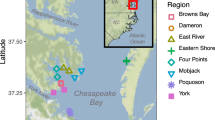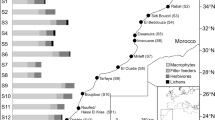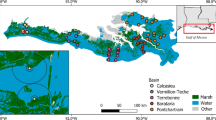Abstract
Sheltered intertidal environments are characterized by highly diversified macroalgal communities which vary over short spatial scales depending on various environmental pressures. In this study, relations between wave heights and vertical elevation were analyzed in order to identify the respective roles of these factors on the structure of macroalgal communities. We measured both wave heights and elevation on six macroalgal communities of three Northeast Atlantic rocky shores. The effects of these structuring factors on seaweed communities were seasonally evaluated in early summer and late autumn using pressure recorders and digital terrain model data. Results reveal that waves were higher during late autumn than in early summer. At shore-scale, elevation was the main factor determining both the structure and the species composition of the macroalgal communities (13.7% of total variance explained), while hydrodynamics played a lower, although significant role (< 1% of the total variance). Based on the cover of canopy-forming species, intertidal macroalgal communities can be grouped into three clusters, corresponding to three height levels on the shore (higher, middle, and lower shore). Canopy composition and structure were mainly explained by the effect of elevation (45%) in the higher level of the shore and by both elevation (42%) and wave height (2.5%) in the middle shore. On the contrary, low shore communities were affected by a more balanced effect of elevation (explaining 14% of the total variance and wave height associated with site effect explaining 15% of such effect). This study gave new insights of how hydrodynamics and elevation condition the extension of macroalgal communities.





Similar content being viewed by others
References
Ar Gall E, Le Duff M (2014) Development of a quality index to evaluate the structure of macroalgal communities. Estuar Coast Shelf Sci 139:99–109
Ar Gall E, Le Duff M, Sauriau PG, de Casamajor MN, Gevaert F, Poisson E, Hacquebart P, Joncourt Y, Barillé AL, Buchet R, Bréret M, Miossec L (2016) Implementation of a new index to assess intertidal seaweed communities as bioindicators for the European Water Framework Directory. Ecol Indic 60:162–173
Bekkby T, Isæus M (2008) Mapping large, shallow inlets and bays: modelling a Natura 2000 habitat with digital terrain and wave-exposure models. ICES J Mar Sci 65:238–241
Bell EC, Denny MW (1994) Quantifying “wave exposure”: a simple device for recording maximum velocity and results of its use at several field sites. J Exp Mar Biol Ecol 181:9–29
Bertolini C (2018) Can secondary species maintain a primary role? Consistent inter-regional effects of understory algae on diversity. Mar Biodivers 49:841–849
Bird CE, Franklin EC, Smith CM, Toonen RJ (2013) Between tide and wave marks: a unifying model of physical zonation on littoral shores. PeerJ 1:e154
Burel T, Schaal G, Grall J, Le Duff M, Chapalain G, Schmitt B, Gemin M, Boucher O, Ar Gall E (2019) Small-scale effects of hydrodynamics on the structure of intertidal macroalgal communities: a novel approach. Estuar Coast Shelf Sci 226:106290
Burrows MT, Harvey R, Robb L (2008) Wave exposure indices from digital coastlines and the prediction of rocky shore community structure. Mar Ecol Prog Ser 353:1–12
Cabioc’h J, Floc’h J-Y, Le Toquin A, Boudouresque CF, Meinesz A, Verlaque M (2014) Algues des mers d’Europe. Guide Delachaux. Delachaux et Niestlé
Chapman ARO (1987) Population and community ecology of seaweeds. Adv Mar Biol 23:1-161
Chappuis E, Terradas M, Cefalì ME, Mariani S, Ballesteros E (2014) Vertical zonation is the main distribution pattern of littoral assemblages on rocky shores at a regional scale. Estuar Coast Shelf Sci 147:113–122
Choi TS, Kim KY (2004) Spatial pattern of intertidal macroalgal assemblages associated with tidal levels. In: Ang PO (ed) Asian Pacific Phycology in the 21st Century: Prospects and Challenges. Springer, Dordrecht, pp 49–56
Connan S (2004) Etude de la diversité spécifique des macroalgues de la Pointe de Bretagne et analyse des composés phénoliques des Phéophycées dominantes. PhD Thesis, University of Brest, France 280 pp
Connan S, Goulard F, Stiger V, Deslandes E, Ar Gall E (2004) Interspecific and temporal variation in phlorotannin levels in an assemblage of brown algae. Bot Mar 47:410–416
Dahlhoff EP (2004) Biochemical indicators of stress and metabolism: applications for marine ecological studies. Annu Rev Physiol 66:183–207
Denny MW (2006) Ocean waves, nearshore ecology, and natural selection. Aquat Ecol 40:439–461
Denny MW, Gaylord B (2002) The mechanics of wave-swept algae. J Exp Biol 205:1355–1362
Denny MW, Wethey DS (2001) Physical processes that generate patterns in marine communities. In: Bertness MD, Gaines SD, Hay ME (eds) Marine Community Ecology. Sinauer, Sunderland, Massachusetts, pp 3–37
Druehl L, Green J (1982) Vertical distribution of intertidal seaweeds as related to patterns of submersion and emersion. Mar Ecol Prog Ser 9:163–170
Fuji A (1988) Measuring wave force on a rocky intertidal shore (潮間帯磯浜での砕波力の測定). Bull Fac Fish Hokkaido Univ 39:257–264
Gaspar R, Pereira L, Neto JM (2017) Intertidal zonation and latitudinal gradients on macroalgal assemblages: species, functional groups and thallus morphology approaches. Ecol Indic 81:90–103
Gaylord B (1999) Detailing agents of physical disturbance: wave-induced velocities and accelerations on a rocky shore. J Exp Mar Biol Ecol 239:85–124
Gaylord B (2000) Biological implications of surf-zone flow complexity. Limnol Oceanogr 45:174–188
Gilman SE, Harley CDG, Strickland DC, Vanderstraeten O, O’Donnell MJ, Helmuth B (2006) Evaluation of effective shore level as a method of characterizing intertidal wave exposure regimes. Limnol Oceanogr-Meth 4:448–457
Golléty C, Thiébaut E, Davoult D (2010) Characteristics of the Ascophyllum nodosum stands and their associated diversity along the coast of Brittany, France. J Mar Biol Assoc UK 91:569–577
Gonçalves M, Martinho P, Guedes Soares C (2014) Wave energy conditions in the western French coast. Renew Energy 62:155–163
Guillou N, Chapalain G (2015) Numerical modelling of nearshore wave energy resource in the Sea of Iroise. Renew Energy 83:942–953
Guinda X, Juanes JA, Puente A (2014) The Quality of Rocky Bottoms index (CFR): a validated method for the assessment of macroalgae according to the European Water Framework Directive. Mar Environ Res 102:3–10
Harley CDG, Helmuth BST (2003) Local- and regional-scale effects of wave exposure, thermal stress, and absolute versus effective shore level on patterns of intertidal zonation. Limnol Oceanogr 48:1498–1508
Hawkins SJ, Hartnoll RG (1985) Factors determining the upper limits of intertidal canopy-forming algae. Mar Ecol Prog Ser 20:265–271
Heaven CS, Scrosati RA (2008) Benthic community composition across gradients of intertidal elevation, wave exposure, and ice scour in Atlantic Canada. Mar Ecol Prog Ser 369:13–23
Helmuth B, Denny MW (2003) Predicting wave exposure in the rocky intertidal zone: do bigger waves always lead to larger forces? Limnol Oceanogr 48:1338–1345
Helmuth BST, Hofmann GE (2001) Microhabitats, thermal heterogeneity, and patterns of physiological stress in the rocky intertidal zone. Biol Bull 201:374–384
Hobday A (1995) Body-size variation exhibited by an intertidal limpet: influence of wave exposure, tidal height and migratory behavior. J Exp Mar Biol Ecol 189:29–45
Holthuijsen LH (2010) Waves in oceanic and coastal waters. Cambridge University Press, Cambridge
Jones WE, Demetropoulos A (1968) Exposure to wave action: measurements of an important ecological parameter on rocky shores on Anglesey. J Exp Mar Biol Ecol 2:46–63
Jonsson PR, Granhag L, Moschella PS, Åberg P, Hawkins SJ, Thompson RC (2006) Interations between wave action and grazing control the distribution of intertidal macroalgae. Ecology 87:1169–1178
Lê S, Josse J, Husson F (2008) FactoMineR: an R package for multivariate analysis. J Stat Softw 25:1–18
Lindegarth M, Gamfeldt L (2005) Comparing categorical and continuous ecological analyses: effects of “wave exposure” on rocky shores. Ecology 86:1346–1357
Little C, Kitching JA (1996) The biology of rocky shores. Oxford University Press, Oxford
Louvart L, Grateau C (2005) The Litto3D project. In: Europe Oceans 2005, 20-23 June 2005. pp 1244–1251 Vol. 1242. https://doi.org/10.1109/OCEANSE.2005.1513237
Malavenda SV, Mitayev MV, Malavenda SS, Gerasimova MV (2017) Fouling of coarse-clastic sediments with macrophytes depending on the rate of abrasion, Murmansk coast. Dokl Earth Sci 474:557–560
Meager JJ, Schlacher TA, Green M (2011) Topographic complexity and landscape temperature patterns create a dynamic habitat structure on a rocky intertidal shore. Mar Ecol Prog Ser 428:1–12
Menge BA, Branch GM (2001) Rocky intertidal communities. In: Bertness MD, Gaines SD, Hay ME (eds) Marine Community Ecology. Sunderland, Sinauer, pp 221–251
Mettam C (1994) Intertidal zonation of animals and plants on rocky shores in the Bristol Channel and Severn Estuary—the northern shores. Biol J Linn Soc 51:123–147
Oksanen J, Blanchet FG, Kindt R, Legendre P, Minchin PR, O’hara R, Simpson GL, Solymos P, Stevens MHH, Wagner H (2013) Package ‘vegan’. Community ecology package, version 2 (9)
Orfanidis S, Panayotidis P, Ugland K (2011) Ecological Evaluation Index continuous formula (EEI-c) application: a step forward for functional groups, the formula and reference condition values. Med Mar Sci 12 (1):34. doi:10.12681/mms.60
Paine RT (1966) Food web complexity and species diversity. Am Nat 100:65–75
Palumbi SR (1984) Measuring intertidal wave forces. J Exp Mar Biol Ecol 81:171–179
Petraitis PS, Fisher JAD, Dudgeon S (2008) Rocky intertidal zone. In: Jørgensen SE, Fath BD (eds) Encyclopedia of Ecology. Academic Press, Oxford, pp 3107–3113
Pocklington JB, Jenkins SR, Bellgrove A, Keough MJ, O’Hara TD, Masterson-Algar PE, Hawkins SJ (2017) Disturbance alters ecosystem engineering by a canopy-forming alga. J Mar Biol Assoc UK 98:687–698
Pratt MC, Johnson AS (2002) Strength, drag, and dislodgment of two competing intertidal algae from two wave exposures and four seasons. J Exp Mar Biol Ecol 272:71–101
Puente A, Guinda X, Juanes JA, Ramos E, Echavarri-Erasun B, De La Hoz CF, Degraer S, Kerckhof F, Bojanić N, Rousou M, Orav-Kotta H, Kotta J, Jourde J, Pedrotti ML, Leclerc J-C, Simon N, Bachelet G, Lavesque N, Arvanitidis C, Pavloudi C, Faulwetter S, Crowe TP, Coughlan J, Cecchi LB, Dal Bello M, Magni P, Como S, Coppa S, De Lucia GA, Rugins T, Jankowska E, Weslawski JM, Warzocha J, Silva T, Ribeiro P, De Matos V, Sousa-Pinto I, Troncoso J, Peleg O, Rilov G, Espinosa F, Ruzafa AP, Frost M, Hummel H, Van Avesaath P (2016) The role of physical variables in biodiversity patterns of intertidal macroalgae along European coasts. J Mar Biol Assoc UK 97:549–560
R Development Core Team (2017) R: a language and environment for statistical computing. R Foundation for Statistical Computing, Vienna Available at : www.R-project org Accessed 1 April 2019
Raffaelli DG, Hawkins SJ (1999) Intertidal ecology, 2nd edn. Kluwer, Dordrecht
Rattray A, Ierodiaconou D, Womersley T (2015) Wave exposure as a predictor of benthic habitat distribution on high energy temperate reefs. Front Mar Sci 2:1–14
Schaal G, Leclerc J-C, Droual G, Leroux C, Riera P (2016) Biodiversity and trophic structure of invertebrate assemblages associated with understorey red algae in a Laminaria digitata bed. Mar Biol Res 12:513–523
Schonbeck M, Norton TA (1978) Factors controlling the upper limits of fucoid algae on the shore. J Exp Mar Biol Ecol 31:303–313
Schonbeck MW, Norton TA (1980) Factors controlling the lower limits of fucoid algae on the shore. J Exp Mar Biol Ecol 43:131–150
Scrosati RA (2017) Community-level facilitation by macroalgal foundation species peaks at an intermediate level of environmental stress. Algae 32:41–46
Scrosati R, Heaven C (2007) Spatial trends in community richness, diversity, and evenness across rocky intertidal environmental stress gradients in eastern Canada. Mar Ecol Prog Ser 342:1–14
Scrosati RA, van Genne B, Heaven CS, Watt CA (2011) Species richness and diversity in different functional groups across environmental stress gradients: a model for marine rocky shores. Ecography 34:151–161
Shanks AL, Morgan SG, MacMahan J, Reniers AJHM (2017) Alongshore variation in barnacle populations is determined by surf zone hydrodynamics. Ecol Monogr 87:508–532
Snickars M, Gullström M, Sundblad G, Bergström U, Downie AL, Lindegarth M, Mattila J (2014) Species–environment relationships and potential for distribution modelling in coastal waters. J Sea Res 85:116–125
Somero GN (2002) Thermal physiology and vertical zonation of intertidal animals: optima, limits, and costs of living. Integr Comp Biol 42:780–789
Sundblad G, Bekkby T, Isæus M, Nikolopoulos A, Norderhaug KM, Rinde E (2014) Comparing the ecological relevance of four wave exposure models. Estuar Coast Shelf Sci 140:7–13
Underwood AJ (1981) Structure of a rocky intertidal community in New South Wales: patterns of vertical distribution and seasonal changes. J Exp Mar Biol Ecol 51:57–85
Underwood AJ, Jernakoff P (1984) The effects of tidal height, wave-exposure, seasonality and rock-pools on grazing and the distribution of intertidal macroalgae in New South Wales. J Exp Mar Biol Ecol 75:71–96
Varing A, Filipot J-F, Roeber V, Leckler F, Duarte R, Michard B, Delpey M (2017) Phase-resolving wave modeling for the wave characterization of coastal and nearshore marine renewable energy sites. Proc 12th Eur Wave Tidal Energy Conf 911:1–8
Watt CA, Scrosati RA (2013) Bioengineer effects on understory species richness, diversity, and composition change along an environmental stress gradient: Experimental and mensurative evidence. Estuar Coast Shelf Sci 123:10–18
Wolcott BD (2007) Mechanical size limitation and life-history strategy of an intertidal seaweed. Mar Ecol Prog Ser 338:1–10
Zacharias MA, Roff JC (2001) Explanations of patterns of intertidal diversity at regional scales. J Biogeogr 28:471–483
Zardi GI, Nicastro KR, Canovas F, Ferreira Costa J, Serrão EA, Pearson GA (2011) Adaptive traits are maintained on steep selective gradients despite gene flow and hybridization in the intertidal zone. PLoS One 6:e19402
Acknowledgments
The Litto3D coastal elevation model used for this study is coproduced by IGN and SHOM and available on https://diffusion.shom.fr/pro/risques/altimetrie-littorale/litto3dr-finistere-2014.html. This work benefited from the experience gained during the Rebent (funded by the Brittany Regional Council and theDREAL at Rennes) and the European Water Framework Directory (Ifremer, Agence de l’Eau Loire – Bretagne, Agence Francaise de la Biodiversite – ONEMA) surveys. Thomas Burel received a fellowship from the Doctoral School of Marine Sciences (Ecole Doctorale des Sciences de la Mer et du Littoral) and the laboratory Lemar UMR6539.The authors thank Wendy Diruit, Maxence Gemin, Simon Haslé, and Blondie Schmitt, for field assistance.
Funding
This work is supported by the Discovery Team (Lemar UMR6539), by ISblue project, Interdisciplinary graduate school for the blue planet (ANR-17-EURE-0015) and co-funded by a grant from the french government under the program "Investissements d'Avenir", and by the Société Phycologique de France (French Phycological Society).
Author information
Authors and Affiliations
Corresponding author
Additional information
Publisher’s note
Springer Nature remains neutral with regard to jurisdictional claims in published maps and institutional affiliations.
Rights and permissions
About this article
Cite this article
Burel, T., Grall, J., Schaal, G. et al. Wave height vs. elevation effect on macroalgal dominated shores: an intercommunity study. J Appl Phycol 32, 2523–2534 (2020). https://doi.org/10.1007/s10811-019-01989-1
Received:
Revised:
Accepted:
Published:
Issue Date:
DOI: https://doi.org/10.1007/s10811-019-01989-1




